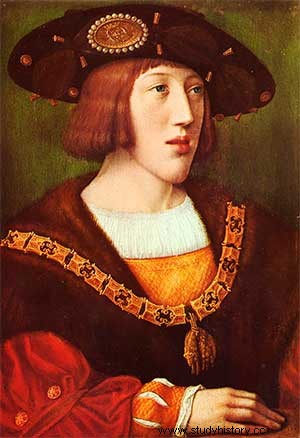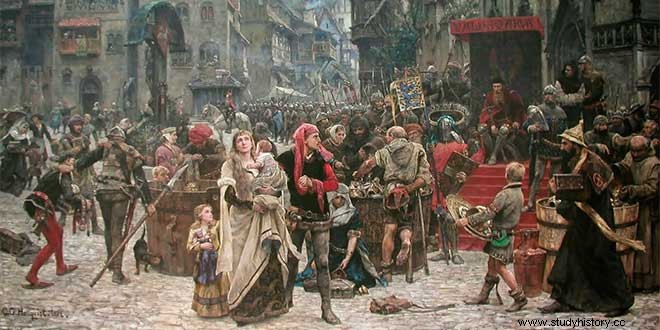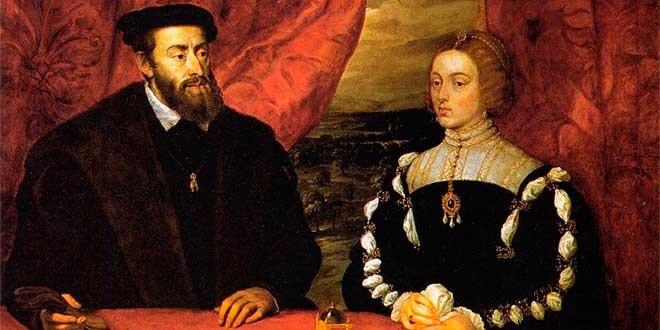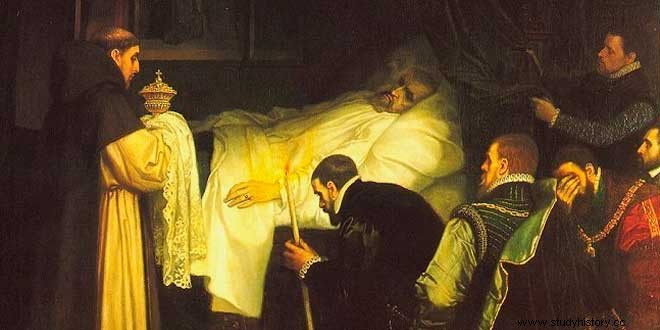Carlos I. King of the crowns of Castile and Aragon (as Emperor of Germany he is Carlos V). He was born on February 24, 1500 in Ghent (Belgium). Son of Juana I and Felipe I. Two teachers were in charge of his education:Chievres and Adriano de Utrecht, who later became Pope Adriano VI (1522-1523). On the death of Fernando el Católico on January 23, 1516, and according to his will, his grandson Carlos I had to take charge of the government of said Crowns under the regency of Cardinal Jiménez de Cisneros, until he came from Flanders. . Carlos I, who was proclaimed at the Court of Brussels on March 14, 1517, associated his former professor Adriano with the regency of Cisneros and sent him to Spain ; later, he arrived in Asturias on September 17, 1517; he then went to Tordesillas to visit his mother.
Start of reign
Cardinal Cisneros, who had gone to receive him, fell ill on the way and died on November 8 of that same year without having seen the king, who entered Valladolid on the 18th of the same month. His first act of his was to distribute, among his Flemish friends, the most important positions of his States and, to his former professor Adriano, he had him created cardinal ; All this produced a great general discontent, which was reproduced again in the Courts of Valladolid in January 1518, where the attorneys of the kingdom made Carlos I swear the laws, before they swore him in as king; later, the deputies presented him with a memorial with 88 petitions, among which they asked that the official documents be signed by him and by his mother; but preceding her name, as owner of the kingdom; that the king speak Spanish, etc. Then the king did what he wanted. He also found opposition in Aragon and Catalonia; but, in the end, he was recognized as king in both places.
Carlos crowned emperor

On January 11, 1519, his grandfather (Maximilian, German Emperor) died; as the succession was elective, Carlos V was elected on June 28, 1519; Charles V achieved the imperial election (June 28, 1519) thanks to corruption and bribery :he used enormous amounts of money, lent by the banker Jacobo Fugger, to pay the German princes who had to designate the new emperor. On May 20, 1520, leaving Cardinal Hadrian as regent, he left for Germany, where he was crowned Emperor of Germany on October 22, 1520 in Aachen.
Revolts and uprising in Castile
Carlos V returned to Spain in July 1522; then, Adriano marched to Rome, to be named Pope. While the absence of Carlos V, the war of the Communities in Castile, and of the Germanías in Valencia took place:the town rose because of the excessive taxes and the insolence of the foreign ministers; but it all ended with the defeat of the rebels at the hands of the regent's army; the leaders of the uprising were beheaded; in Villalar de los Comuneros (Valladolid):Juan de Padilla, Juan Bravo and Francisco Maldonado on April 24, 1521; The Germanías also ended with the execution of their leaders:in Orihuela (Alicante), Pedro Palomares and the thirteen who formed the Junta de Orihuela were beheaded; in Valencia, Vicente Peris was assassinated; in Burjasot, the Undercover (a mysterious character, who presented himself as a grandson of the Catholic Monarchs, a supposed son of Prince Juan, and also as a prophet) was assassinated on May 19, 1522 and, later, the Inquisition judged him posthumously and ordered to burn his body.
War with France
Charles V soon began his first war against the King of France, Francis I (1515-1547), who had invaded Navarre, where he was repulsed; then he was taken prisoner at the battle of Pavia (Italy) on February 24, 1525 and brought to Madrid; he did not recover his freedom until he agreed, under oath, to comply with the harsh conditions of the Concord of Madrid of January 14, 1526, after which he went to France on February 21 of the same year; On the following March 18, Francisco I arrived at the border of the Bidasoa river, where he was exchanged for his two sons (Francisco and Enrique), who he left as hostages in Spain. Later, the French king, in addition to refusing to comply with the provisions of said Concord, formed the Holy League with Pope Clement VII (1523-1534), Venice and the Duke of Milan (Francisco Sforza).
Assault on Rome
The Pope dispensed Francis I from the oath made to fulfill the Concord of Madrid. Charles V was furious and launched his armies against his enemies of that League:a large army, commanded by the Duke of Bourbon, arrived before Rome and launched an assault on the city on May 6, 1527 ; As the duke first scaled the walls, he fell dead from a musket shot; but his soldiers, like furious vermin, entered Rome; everything was razed to the ground, looted and raped:the married women before their husbands, the maidens before their mothers, the nuns in their convents assaulted; the cardinals, slapped and mounted on donkeys, exposed to the greatest ridicule, had to buy their freedom at the price of gold; churches were looted and their gold stolen; even the tombs were desecrated and robbed; The body of Pope Julius II (1503-1513) had his gold ring stolen. The barbarians of the pagan Attila had respected the city of Rome; but the soldiers of the very Christian Emperor Charles V were more barbaric than those:for three days, drunk with wine and lust, they roamed and ravaged the city, and some 8,000 of its inhabitants were put to the sword. The pope, after being subjected to all kinds of outrages, was held in prison in the castle of Sant Angelo with thirteen cardinals . The Prince of Orange (Filiberto de Chalons), who had succeeded the Duke of Bourbon in command of the army, entrusted Don Juan de Castilla with the government of the city.

Liberationofthepope
The Pope, in order to recover his freedom, had to accept the humiliating conditions that were placed on him:hand over to Carlos V the cities of Parma, Ostia and Plasencia, and almost all the church squares, as well as a large sum of money and remain a prisoner until he fulfilled all of this agreement. When Charles V found out about the captivity of the Pope, he ordered prayers to be made in all the churches of his States for the release of the Supreme Pontiff, instead of condemning his release.
The Pope, when he had been a prisoner for seven months, escaped from the castle of Sant Angelo and went to Orvieto, where the Holy League camp was . Charles V's army, decimated by a plague, left Rome.
Francisco I pays ransom
The war continued against Francisco I until the Peace of Cambray (or of the Ladies) on August 5, 1629; in it, it was agreed that Francisco I would pay 2,000,000 gold shields for the ransom of his children, first handing over what he had in the Milanese and renouncing his rights to the sovereignty of Flanders and Artois, as well as Milan, Naples, Genoa and other cities in Italy. In that same year, Suleiman the Magnificent (Ottoman sultan of Constantinople, 1495-1566) laid siege to the city of Vienna with an army of 120,000 men; but was rejected; Count Salm made him leave the siege. Later, in Bologna, on February 24, 1530, the day Charles V turned 30 years old, he received two crowns:the Pope, who, after the sack of Rome and his captivity, had already made peace with Charles V, crowned him as emperor of the Holy Roman Empire , and, in addition, he received the Iron Crown of Lombardy.
Treaty of Nice and peace with France
Later, Francisco I appropriated most of the lands of the Duke of Savoy (brother-in-law and ally of the Emperor) and claimed the Duchy of Milan; so Carlos V went against him again; thus began the third war between the two, which ended on June 18, 1538 with the Treaty of Nice , where a ten-year truce was agreed and during this time, each party would keep what they owned at that time; But before the end of those ten years, the fourth war began between the French king and Emperor Francis I, allied with the kings of Denmark, with Venice and with the Duke of Eleves, he declared war on Charles V and invaded his domains with five armies.; but the emperor allied himself with Henry VIII of England, and with an army of 30,000 men, launched himself against his enemies, then increased that number to 50,000, and, with them, went over Paris; the terrified French king sued for peace, which was signed at Crespy on September 18, 1544 . Francis I had to promise to return everything he had conquered since the Nice truce, renounce his rights over the kingdoms of Naples and Sicily, not give aid to the dethroned King of Navarre and join Charles V to fight against the Turks.
Carlos V fights barbarossa
The pirate Barbarossa (Haradín), at the service of Suleiman the Magnificent, had seized the kingdom of Tunisia dethroning its king Muley Hassan, and, from there, after having raided and plundered the coasts of Spain and Italy, he was preparing to go against the latter. country. Charles V went against Barbarossa , and, after defeating him, he entered Tunis on July 21, 1535, freed more than 12,000 Catholic captives, which he had held there Barbarossa , who fled. Carlos V replaced Muley Hasán on the throne, as his vassal and tributary, and returned to Europe . Hasan Aga, governor of Algiers, was another terrible pirate like Barbarossa . Carlos V went against him; on October 13, 1541, he reached the coast of Algiers; but a terrible storm destroyed a large part of his ships; so, returning without achieving his objective, he arrived in Cartagena in December of the same year.
Conquest of new lands in America
While Charles V was waging all these wars for Africa and Europe, large tracts of land were added to his New World states :Hernán Cortés conquered Mexico (1519 – 1522); Pizarro, Peru (1531 – 1533); Almagro, Chile (in 1535; but returned immediately, so it was conquered again by Pedro de Valdivia in 1540); Orellana, the Amazon in 1541, etc.
Marriage and descendants
In 1526, he married his first cousin Isabella of Portugal, who died in 1539 (daughter of King Manuel I of Portugal and his wife Maria de Castilla, daughter of the Catholic Monarchs). Carlos V had, from this marriage, Felipe, María and Juana . He also had several natural and bastard children, among them, Margarita de Parma or de Austria (1528-1586), Tadea, and Juan de Austria (Jerónimo) born in February 1547. There is no doubt that few men have come to have as much power as Emperor Charles V (because, as we have seen, he had five crowns:those of Castile, Aragon, Germany, the Holy Roman Empire, Lombardy), nor have they suffered such a bitter failure in their conscience, seeing their promises made frustrated conjured before the Pope in 1530, which he could not fulfill despite having so much power and being a determined promoter of the Inquisition.

BeginningsofLutheranism
On the other hand, Martin Luther (1483-1546), a priest since 1507, was appointed Professor of Philosophy at the University of Witenberg (Germany) in 1508, where he attained the degree of Doctor of Holy Scripture in 1512; he continued there as professor of Theology; between 1513-1515, he explained the psalms, and, between 1515-1516, the Epistle to the Romans. In 1506, Pope Julius II (1503-1513) conceived the project to build the Cathedral of Saint Peter and he published an indulgence, to raise funds for that work; he commissioned the preaching of this indulgence to the Franciscans. Pope Leo X (1513-1521) renewed and promoted everything related to said indulgence and its preaching. Tetzel was in charge of preaching indulgences in Germany, and he said:“As soon as a coin in the coffers sounds, a soul in purgatory escapes its pain” . On October 31, 1517, Martin Luther posted 95 theses against the preaching of indulgences on the door of the Witenberg church , and also sent them to the Archbishop of Mainz, who forwarded them to the Pope, who, after many controversies that followed with Luther (who, in 1518, introduced, in the debates, the doctrine of justification only by faith), on June 15, 1520, issued the Bull Exurge Domine*; in it, he condemned 41 propositions of Luther and excommunicated him if he did not retract and submit within sixty days. Luther, after writing (according to what he said) against the Bull of Antichrist, burned it together with the books of Canon Law on December 10, 1520 in front of the church of Witenberg.
Charles V's oath to the pope
On October 23 of the same year, Carlos V was crowned in Aachen as Emperor of Germany; and, on February 24, 1530 in Bologna, the Pope crowned him as Holy Roman Emperor; As part of this coronation ceremony, the Emperor did the following:after kissing the Pope's foot, he swore that he would be a protector and defender of the Roman Church, of the Catholic religion and of the person of the Pope and his successors. of the; then, kneeling, he received, from the hands of the Pope, the sacred ring and the sword, and promised to be a soldier of Saint Peter; kneeling again, the Pope placed the golden crown on his head; in the left, the scepter, and, in the right, a globe of the world as a sign of his sovereignty over all the Earth, after which he was proclaimed three times as emperor. It is evident that Charles V was crowned Emperor of Germany and after the Holy Roman-Germanic Empire (which existed from February 2, 962 to August 6, 1806) when Luther had already broken the unity of the Catholic Church in Germany; Emperor Charles V devoted his entire life to reestablishing that unity; so, in February 1521, he convened the Diet of Worms , in which Luther presented himself with an imperial safe-conduct on April 17; there he refused to recant unless he was first shown by the Bible that he was wrong; before this, the emperor ordered him to leave, and, after the term of the safe conduct, published, on May 8, the Edict of Worms, in which he proscribed Luther and his supporters, and ordered his writings of all kinds to be destroyed. Thus began the fight of Emperor Charles V against Luther, his doctrines and his followers;
Catholicismo contra luteranismo
The positions of both sides became more and more radical. The Lutherans suppressed celibacy in April 1521 and, in the autumn of the same year, suppressed the idolatrous mass in Witenberg with the approval of the University of this city . On April 25, 1529, at the Diet of Speyer , the Lutherans began their intervention by saying:“We protest…” , which means:“We declare… ” and, from there, they were given the name of “protestants ”. In June 1530, the Diet of Augsburg took place , presided over by Carlos V, who rejected the Protestant Confession of Faith drawn up by the Lutheran Melanchthon. On the other hand, Ignacio de Loyola founded the Society of Jesus (Jesuits), approved by Pope Paul III on September 27, 1540, to fight against the Lutherans. After endless disputes, he resorted to arms. In March 1531, the Lutheran Estates formed the League of Schmalkanda; Carlos V adjusted with them the religious Peace of Nuremberg on June 22, 1532 until the celebration of a Council; but, in 1538, the German Catholic States formed the Nuremberg Defensive League. Finally, Pope Paul III convened the Council of Trent, which took place in three periods (12-13-1545 to 6-2-1547; 5-1-1551 to 4-18-1552, and 1-18-1562). to 4-12-1563), during which these Popes succeeded each other:Paul III (1534-1549), Julius III (1550-1555), Marcellus II (1555), Paul IV (1555-1559) and Pius IV (1559 -1565). This Council was in charge of determining and strengthening the Catholic dogmas against the doctrines of Luther , following point by point the doctrines of the Protestant Augsburg Confession of Faith. However, both sides led to a religious war, in which the Lutherans were defeated at Mühlberg (Saxony) in 1547; but, in 1551, Mauritius of Saxony again led the war against Charles V, who after being defeated and about to be taken prisoner, was forced to accept the Treaty of Passau in 1552 (established between his brother Ferdinand I and the Lutheran princes) by which the Lutheran religion was legalized and publicly recognized; this was ratified by the Peace of Augsburg in 1555, which sealed the religious division of Germany and ended all hopes of Charles V for reestablishing religious unity in that country; Well, let's not forget that he had sworn before the Pope to defend the Catholic religion.

Carlos V, abdicates the throne and his death
Having failed so resoundingly this company so cherished by the emperor, the latter sick and tired of so much war, after having carried out forty warlike expeditions through Africa and Europe, abdicated, on October 25, 1555 in Brussels, the States of Flanders and Brabant in his son Felipe. On January 16, 1556, he abdicated the crowns of Castile and Aragon also in Felipe . A few days later, he abdicated the crown of the Empire in his son Fernando, and, on September 17 of the same year, he embarked for Castile. On February 3, 1557, he entered the monastery of Yuste (Cáceres), where he died on September 21, 1558. As regards the Netherlands, which were seventeen provinces that apparently belonged to the Holy Roman Empire, Charles V, in 1548, decided that henceforth they would be united and ruled by the king of Castile and Aragon, and not by the emperor .
